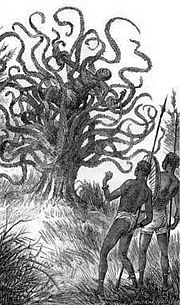
October 23, 2007

Depiction of a native being consumed by a Ya-te-veo (“I can see you”) carnivorous tree of Central America, from Land and Sea by J.W. Buel, 1887. Source: Wikipedia. (The image appears to be from a woodcut, naturally.)
In Roy Mackal’s book, Searching for Hidden Animals (NY: Doubleday, 1980), his last chapter is entitled “The Monstrous Plants.” It was not about cryptozoology, needless to say, but about cryptobotany, being a short treatise on the Victorian accounts of man-eating plants.
As Mackal points out, many zoologists and botanists have been fascinated by plants that eat meat since the days when Charles Darwin was bitten by this interest, and wrote a definitive work on the subject, Insectivorous Plants, published in 1888.
Like Mackal, who tells of having acquired several varieties of carnivorous plants after reading about them in Darwin, I recall as a boy buying and successfully raising Venus flytraps (Dionaena muscipula), after reading about the plants in Willy Ley’s Salamanders and Other Wonders (NY: Viking, 1955).
Recently, I’ve actually thought about getting some more, to raise them in this bay window here at the museum. The plants still intrigue me. Nature does have some fine wonders.
Anyway, Mackal spends his final chapter detailing mostly the reports from the 1850s through the 1940s of the “Man-Eating Tree of Madagacar,” and the expeditions that searched (unsuccessfully) for the species.
Little did I imagine that I would run across a new story of a similar nature, but here it is, from today, from South India: “Cow-eating trees of Padrame.”
Mangalore: Carnivorous trees grabbing humans and cattle and gobbling them up is not just village folklore.
Residents of Padrame near Kokkoda in Uppinangady forest range sighted one such carnivorous tree trying to dine on a cow last Thursday [October 18, 2007]. According to reports, the cow owned by Anand Gowda had been left to graze in the forests.
The cow was suddenly grabbed by the branches and pulled from the ground. The terrified cowherd ran to the village, and got Gowda and a band of villagers to the carnivorous tree.
Before the tree could have its meal, Anand Gowda and the villagers struck mortal blows to the branches that turned limp and the cow was rescued. Uppinangady range forest officer (RFO) Subramanya Rao said the tree was described as ‘pili mara’ (tiger tree) in native lingo.
He had received many complaints about cattle returning home in the evenings without tails. On Friday, the field staff confirmed coming across a similar tree in Padrane, partially felled down.
However no detailed inquiry was made as the authorities were not asked for any report, Rao said.‘Cow-eating’ trees of Padrame, Tuesday, October 23, 2007, Express News Service, New IndPress.
About Loren Coleman
Loren Coleman is one of the world’s leading cryptozoologists, some say “the” leading living cryptozoologist. Certainly, he is acknowledged as the current living American researcher and writer who has most popularized cryptozoology in the late 20th and early 21st centuries.
Starting his fieldwork and investigations in 1960, after traveling and trekking extensively in pursuit of cryptozoological mysteries, Coleman began writing to share his experiences in 1969. An honorary member of Ivan T. Sanderson’s Society for the Investigation of the Unexplained in the 1970s, Coleman has been bestowed with similar honorary memberships of the North Idaho College Cryptozoology Club in 1983, and in subsequent years, that of the British Columbia Scientific Cryptozoology Club, CryptoSafari International, and other international organizations. He was also a Life Member and Benefactor of the International Society of Cryptozoology (now-defunct).
Loren Coleman’s daily blog, as a member of the Cryptomundo Team, served as an ongoing avenue of communication for the ever-growing body of cryptozoo news from 2005 through 2013. He returned as an infrequent contributor beginning Halloween week of 2015.
Coleman is the founder in 2003, and current director of the International Cryptozoology Museum in Portland, Maine.
Filed under Breaking News, Cryptobotany, Cryptomundo Exclusive, Cryptotourism, CryptoZoo News, Cryptozoologists, Cryptozoology, Eyewitness Accounts, Folklore